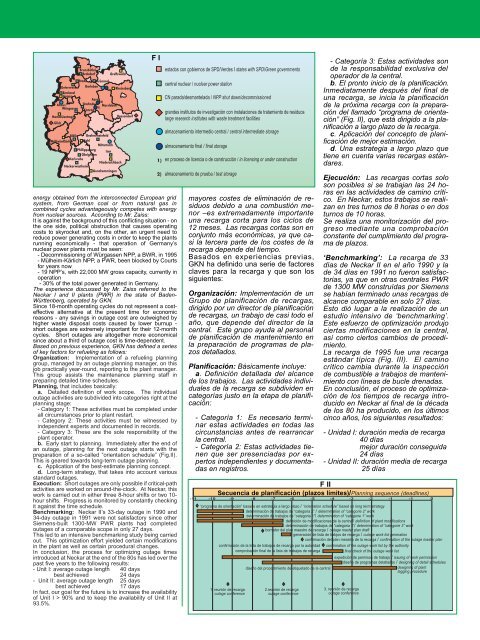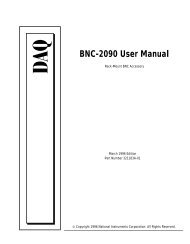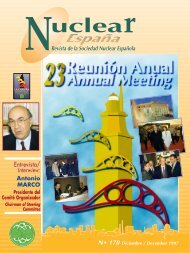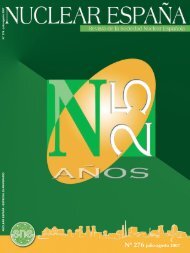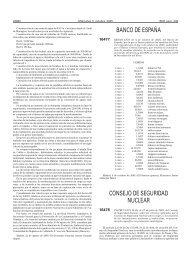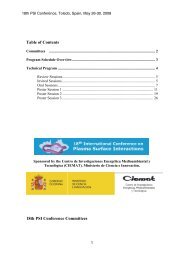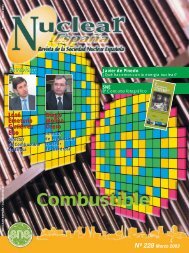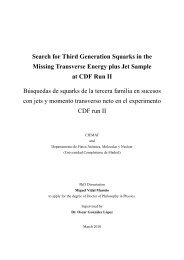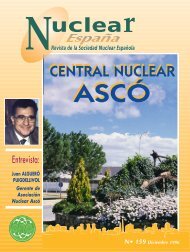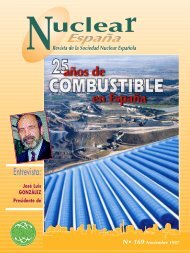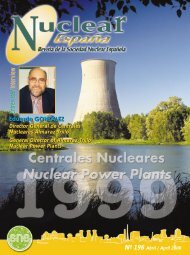You also want an ePaper? Increase the reach of your titles
YUMPU automatically turns print PDFs into web optimized ePapers that Google loves.
AhausWürgassenHammUentropJülichStade KrümmelUnterweser GorlebenEmslandLingenBrunsbütlelBrokdorfGrelfswaldAsse2)GrohndeMorsleben1)KonradBiblis GrafenrheinfeldMülhelmKärlich KahlMittertelchPhillippsburgIsarObrigheimKarlsruheNiederalchbachNeckarwestheimGundremmingenRheinsbergRossendorfF Ienergy obtained from the interconnected European gridsystem, from German coal or from natural gas incombined cycles advantageously competes with energyfrom nuclear sources. According to Mr. Zaiss:It is against the background of this conflicting situation - onthe one side, political obstruction that causes operatingcosts to skyrocket and, on the other, an urgent need toreduce power generating costs in order to keep the plantsrunning economically - that operation of Germany’snuclear power plants must be seen:- Decommissioning of Würgassen NPP, a BWR, in 1995- Mülheim-Kärlich NPP, a PWR, been blocked by Courtsfor years now- 19 NPP’s, with 22,000 MW gross capacity, currently inoperation- 30% of the total power generated in Germany.The experience discussed by Mr. Zaiss referred to theNeckar I and II plants (PWR) in the state of Baden-Württenberg, operated by GKN.Since 18-month operating cycles do not represent a costeffectivealternative at the present time for economicreasons - any savings in outage cost are outweighed byhigher waste disposal costs caused by lower burnup -short outages are extremely important for their 12-monthcycles. Short outages are altogether more economicalsince about a third of outage cost is time-dependent.Based on previous experience, GKN has defined a seriesof key factors for refueling as follows:Organization: Implementation of a refueling planninggroup, managed by an outage planning manager, on thisjob practically year-round, reporting to the plant manager.This group assists the maintenance planning staff inpreparing detailed time schedules.Planning, that includes basically:a. Detailed definition of work scope. The individualoutage activities are subdivided into categories right at theplanning stage:- Category 1: These activities must be completed underall circumstances prior to plant restart.- Category 2: These activities must be witnessed byindependent experts and documented in records.- Category 3: These are the sole responsibility of theplant operator.b. Early start to planning. Immediately after the end ofan outage, planning for the next outage starts with thepreparation of a so-called “orientation schedule” (Fig.II).This is geared towards long-term outage planning.c. Application of the best-estimate planning concept.d. Long-term strategy, that takes into account variousstandard outages.Execution: Short outages are only possible if critical-pathactivities are worked on around-the-clock. At Neckar, thiswork is carried out in either three 8-hour shifts or two 10-hour shifts. Progress is monitored by constantly checkingit against the time schedule.Benchmarking: Neckar II’s 33-day outage in 1990 and34-day outage in 1991 were not satisfactory since otherSiemens-built 1300-MW PWR plants had completedoutages of a comparable scope in only 27 days.This led to an intensive benchmarking study being carriedout. This optimization effort yielded certain modificationsin the plant as well as certain procedural changes.In conclusion, the process for optimizing outage timesintroduced at Neckar at the end of the 80s has led over thepast five years to the following results:- Unit I: average outage length 40 daysbest achieved24 days- Unit II: average outage length 25 daysbest achieved17 daysIn fact, our goal for the future is to increase the availabilityof Unit I > 90% and to keep the availability of Unit II at93.5%.estados con gobiernos de SPD/Verdes / states with SPD/Green governmentscentral nuclear / nuclear power stationCN parada/desmantelada / NPP shut down/decommissionedgrandes institutos de investigación con instalaciones de tratamiento de residuoslarge research institutes with waste treatment facilitiesalmacenamiento intermedio central / central intermediate storagealmacenamiento final / final storage1) en proceso de licencia o de construcción / in licensing or under construction2) almacenamiento de prueba / test storagemayores costes de eliminación de residuosdebido a una combustión menor–es extremadamente importanteuna recarga corta para los ciclos de12 meses. Las recargas cortas son enconjunto más económicas, ya que casila tercera parte de los costes de larecarga depende del tiempo.Basados en experiencias previas,GKN ha definido una serie de factoresclaves para la recarga y que son lossiguientes:Organización: Implementación de unGrupo de planificación de recargas,dirigido por un director de planificaciónde recargas, un trabajo de casi todo elaño, que depende del director de lacentral. Este grupo ayuda al personalde planificación de mantenimiento enla preparación de programas de plazosdetallados.Planificación: Básicamente incluye:a. Definición detallada del alcancede los trabajos. Las actividades individualesde la recarga se subdividen encategorías justo en la etapa de planificación:- Categoría 1: Es necesario terminarestas actividades en todas lascircunstancias antes de rearrancarla central.- Categoría 2: Estas actividades tienenque ser presenciadas por expertosindependientes y documentadasen registros.- Categoría 3: Estas actividades sonde la responsabilidad exclusiva deloperador de la central.b. El pronto inicio de la planificación.Inmediatamente después del final deuna recarga, se inicia la planificaciónde la próxima recarga con la preparacióndel llamado “programa de orientación”(Fig. II), que está dirigido a la planificacióna largo plazo de la recarga.c. Aplicación del concepto de planificaciónde mejor estimación.d. Una estrategia a largo plazo quetiene en cuenta varias recargas estándares.Ejecución: Las recargas cortas soloson posibles si se trabajan las 24 horasen las actividades de camino crítico.En Neckar, estos trabajos se realizanen tres turnos de 8 horas o en dosturnos de 10 horas.Se realiza una monitorización del progresomediante una comprobaciónconstante del cumplimiento del programade plazos.‘Benchmarking’: La recarga de 33días de Neckar II en el año 1990 y lade 34 días en 1991 no fueron satisfactorias,ya que en otras centrales PWRde 1300 MW construídas por Siemensse habían terminado unas recargas dealcance comparable en solo 27 días.Esto dió lugar a la realización de unestudio intensivo de ‘benchmarking’.Este esfuerzo de optimización produjociertas modificaciones en la central,así como ciertos cambios de procedimiento.La recarga de 1995 fue una recargaestándar típica (Fig. III). El caminocrítico cambia durante la inspecciónde combustible a trabajos de mantenimientocon líneas de bucle drenadas.En conclusión, el proceso de optimizaciónde los tiempos de recarga introducidoen Neckar al final de la décadade los 80 ha producido, en los últimoscinco años, los siguientes resultados:- Unidad I: duración media de recarga40 díasmejor duración conseguida24 días- Unidad II: duración media de recarga25 díasF IISecuencia de planificación (plazos límites)/Planning sequence (deadlines)-11 -10 -9 -8 -7 -6 -5 -4 -3 -2 -1 -1 0“programa de orientación” basado en estrategia a largo plazo / “orientation schedule” based on long term strategydeterminación de trabajos de “categoria 2” / determination of “categorie 2” workdeterminación de trabajos de “categoria 1”/ determination of “categorie 1” workdefinición de modificaciones de la central/ definition of plant modificationsdeterminación de trabajos de “categoria 3”/ determination of “categorie 3” workborrador del plan maestro de recarga / outage master plan draft 1generación de lista de trabjos de recarga / outage work list generationconfirmación del plan meastro de la recarga / confirmation of the outage master planconfirmación de la lista de trabajos de recarga por la autoridad confirmation of the outage work list by the authoritycomprobación final de la lista de trabajos de recargafinal check of the outage work listexpedición de permisos de trabajo / issuing of work permissiondiseño de programas detallados / designing of detail schedulesdiseño del procedimiento de etiquetado de la centraldesigning of planttagging procedure1. reunión de recargaoutage conference2.reunión de recargaoutage conference3. reunión de recargaoutage conference


